Nonwestern Art- China

Nonwestern Blog- Early Qing Dynasty China China has a long history and centuries worth of art. I decided to focus on the traditional ink art paintings from the early Qing Dynasty. Wooded Mountains at Dusk , Kuncan, 1666, China The Wooded Mountains at Dusk is a beautiful work painted by the Buddhist artist Kuncan. Kuncan was a friend of poet-artists, and after visiting Yellow Mountain in southern Anhui Province he was inspired to paint and followed his friends' methods ( Wooded Mountains at Dusk ). The detailed use of lines, forming the landscape, and void space, appearing as a stream and mist, create foggy wooded mountains that offer a feeling of mystery and intrigue. This, combined with the poem ( translation ), gives a feeling of being present while giving you something to contemplate while enjoying the work. Viewing a waterfall from a mountain pavilion , Li Yin, 1700, Yangzhou, China Another Stunning work ...





